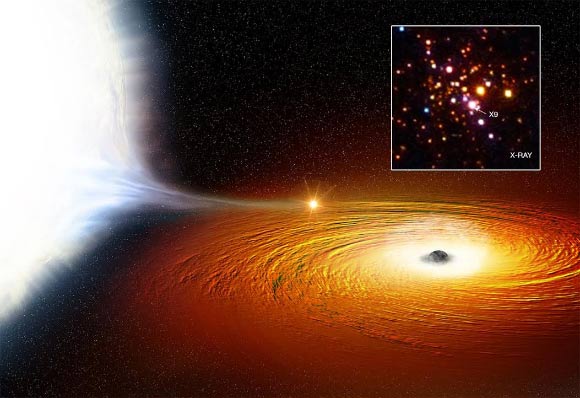Using data from the Australia Telescope Compact Array, NASA’s Chandra X-ray Observatory and NuSTAR telescope, a team of astronomers has found evidence for a white dwarf star that whips around a stellar-mass black hole about twice an hour. A paper describing the discovery will be published in the Monthly Notices of the Royal Astronomical Society (arXiv.org preprint).

An artist’s impression of a white dwarf star (left) in orbit around a black hole and so close that much of its material is being pulled away. Inset is an observation of 47 Tucanae captured by NASA’s Chandra X-ray Observatory. The binary system — 47 Tuc X9 — is indicated by the arrow, and low, medium, and high-energy X-rays are colored red, green, and blue respectively. Image credit: NASA / CXC / University of Alberta / A. Bahramian et al / M. Weiss.
The close-in binary system — known as 47 Tuc X9 — is located in 47 Tucanae, a dense cluster of stars approximately 15,300 light-years away from Earth.
Also known as NGC 104, 47 Tucanae is one of the brightest and most massive globular clusters known. At about 120 light-years across, this grouping of stars is so large that, despite its distance, it looks about as big as the full Moon.
While astronomers have observed 47 Tuc X9 for many years, it wasn’t until 2015 that radio observations revealed the pair likely contains a black hole pulling material from a white dwarf.
New Chandra data of this binary system show that it changes in X-ray brightness in the same manner every 28 minutes, which is likely the length of time it takes the companion star to make one complete orbit around the black hole.
Chandra data also show evidence for large amounts of oxygen in the system a characteristic of white dwarfs.
A strong case can, therefore, be made that that the companion star is a white dwarf, which would then be orbiting the black hole at only about 2.5 times the separation between the Earth and the Moon.
“This white dwarf is so close to the black hole that material is being pulled away from the star and dumped onto a disk of matter around the black hole before falling in. Luckily for this star, we don’t think it will follow this path into oblivion, but instead will stay in orbit,” said lead author Dr. Arash Bahramian, from the University of Alberta and Michigan State University.
Although the white dwarf does not appear to be in danger of falling in or being torn apart by the black hole, its fate is uncertain.
“We think the star may have been losing gas to the black hole for tens of millions of years and by now has now lost the majority of its mass,” said co-author Dr. James Miller-Jones, from Curtin University and the International Centre for Radio Astronomy Research.
“Over time, we think that the star’s orbit will get wider and wider as even more mass is lost, eventually turning into an exotic object similar to the famous diamond planet discovered a few years ago.”
“For a long time astronomers thought that black holes were rare or totally absent in globular star clusters. This discovery is additional evidence that, rather than being one of the worst places to look for black holes, globular clusters might be one of the best,” added co-author Dr. Jay Strader, from Michigan State University.
How did the black hole get such a close companion? One possibility is that the black hole smashed into a red giant star, and then gas from the outer regions of the star was ejected from the binary. The remaining core of the red giant would form into a white dwarf, which becomes a binary companion to the black hole.
The orbit of the binary would then have shrunk as gravitational waves were emitted, until the black hole started pulling material from the white dwarf.
An alternative explanation is that the white dwarf is partnered with a neutron star, rather than a black hole.
“An alternative theory would involve a neutron star that’s being spun up as material is pulled away by the black hole,” explained co-author Dr. Vlad Tudor, from Curtin University and the International Centre for Radio Astronomy Research.
“Much like a spinning top as you pull the string from around its middle to make it go — but this theory doesn’t explain everything we’re seeing here, so our best current explanation is that we’re dealing with a white dwarf in extremely close proximity to a black hole.”
_____
Arash Bahramian et al. 2017. The ultracompact nature of the black hole candidate X-ray binary 47 Tuc X9. MNRAS, in press; arXiv: 1702.02167







